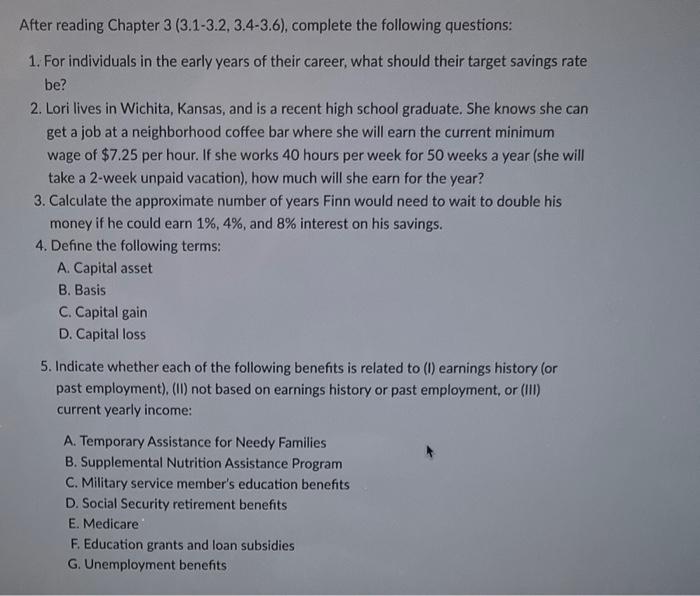1. For individuals in the early years of their career, what should their target savings rate be? 2. Lori lives in Wichita, Kansas, and is a recent high school graduate. She knows she can get a job at a neighborhood coffee bar where she will earn the current minimum wage of $7.25 per hour. If she works 40 hours per week for 50 weeks a year (she will take a 2-week unpaid vacation), how much will she earn for the year? 3. Calculate the approximate number of years Finn would need to wait to double his money if he could earn 1%,4%, and 8% interest on his savings. 4. Define the following terms: A. Capital asset B. Basis C. Capital gain D. Capital loss 5. Indicate whether each of the following benefits is related to (I) earnings history (or past employment), (II) not based on earnings history or past employment, or (III) current yearly income: A. Temporary Assistance for Needy Families B. Supplemental Nutrition Assistance Program C. Military service member's education benefits D. Social Security retirement benefits E. Medicare F. Education grants and loan subsidies G. Unemployment benefits 1. For individuals in the early years of their career, what should their target savings rate be? 2. Lori lives in Wichita, Kansas, and is a recent high school graduate. She knows she can get a job at a neighborhood coffee bar where she will earn the current minimum wage of $7.25 per hour. If she works 40 hours per week for 50 weeks a year (she will take a 2-week unpaid vacation), how much will she earn for the year? 3. Calculate the approximate number of years Finn would need to wait to double his money if he could earn 1%,4%, and 8% interest on his savings. 4. Define the following terms: A. Capital asset B. Basis C. Capital gain D. Capital loss 5. Indicate whether each of the following benefits is related to (I) earnings history (or past employment), (II) not based on earnings history or past employment, or (III) current yearly income: A. Temporary Assistance for Needy Families B. Supplemental Nutrition Assistance Program C. Military service member's education benefits D. Social Security retirement benefits E. Medicare F. Education grants and loan subsidies G. Unemployment benefits







